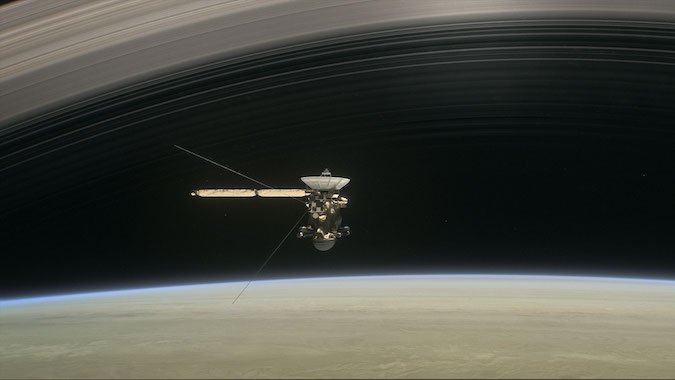Track Cassini's Final Moments Orbiting Saturn
The Cassini spacecraft will end its 20 year mission to observe Saturn by plunging into the gas giant's outer atmosphere.

Entire careers have been defined by a 12,593 pound hunk of metal and minerals hurtling around one of the most enigmatic planets in our solar system. Now, its time has come.
Here, we’ll be covering Cassini’s final moments orbiting Saturn. Earlier this year, the spacecraft slipped between the innermost ring and the planet, gathering more data on the rings and the planet itself. On Friday, September 15, NASA is planning to send Cassini plunging into Saturn’s atmosphere, beaming back data as it does. This final act is intentional, planned to prevent the probe from contaminating one of several potentially life-supporting moons that orbit the planet.
Friday, September 15, 4:55 am PT: Earth has lost contact with Cassini for good, indicating that the spacecraft has reached its final destiny. Read what happened here , relive Cassini’s top accomplishments , and watch our tribute:
Thursday, September 14, 1:22 pm PT: Cassini has turned its antennae to Earth and is now in the process of transmitting everything on its data recorders. This 11-hour downlink will begin with the NASA Deep Space Network (or DSN) antenna station in California, which then hands off the receipt of data to a station in Australia (once the Earth rotates enough) for the rest of the mission. The primary navigation system will also change from the reaction wheels to the attitude thrusters, which are much more powerful.
Wednesday, September 13, 10 am PT: Cassini has lived a long, fruitful life. In 20 years, it has discovered seas of liquid methane and ethane on Saturn’s moon Titan, witnessed plumes of salty water spewing from Enceladus, observed Saturn’s north polar jet stream known as “the hexagon,” and much more :
On Monday, Cassini waved goodbye to Titan (giving it the slightest nudge toward destiny), swug out to apoapsis (the point at which an object is farthest away from the body it’s orbiting), and commenced the dive. We’re sitting in on this morning’s press conference about what lies ahead over the next days. Check out this Twitter thread for a synopsis of the conference’s highlights:
Soon Cassini will be “essentially a real-time instrument”; we’ll receive data much more quickly than before. —Earl Maize #CassiniPBS (5/n)
— NOVA | PBS (@novapbs) September 13, 2017
Don’t miss “Death Dive to Saturn,” streaming online .
Image credit: NASA/JPL-Caltech



